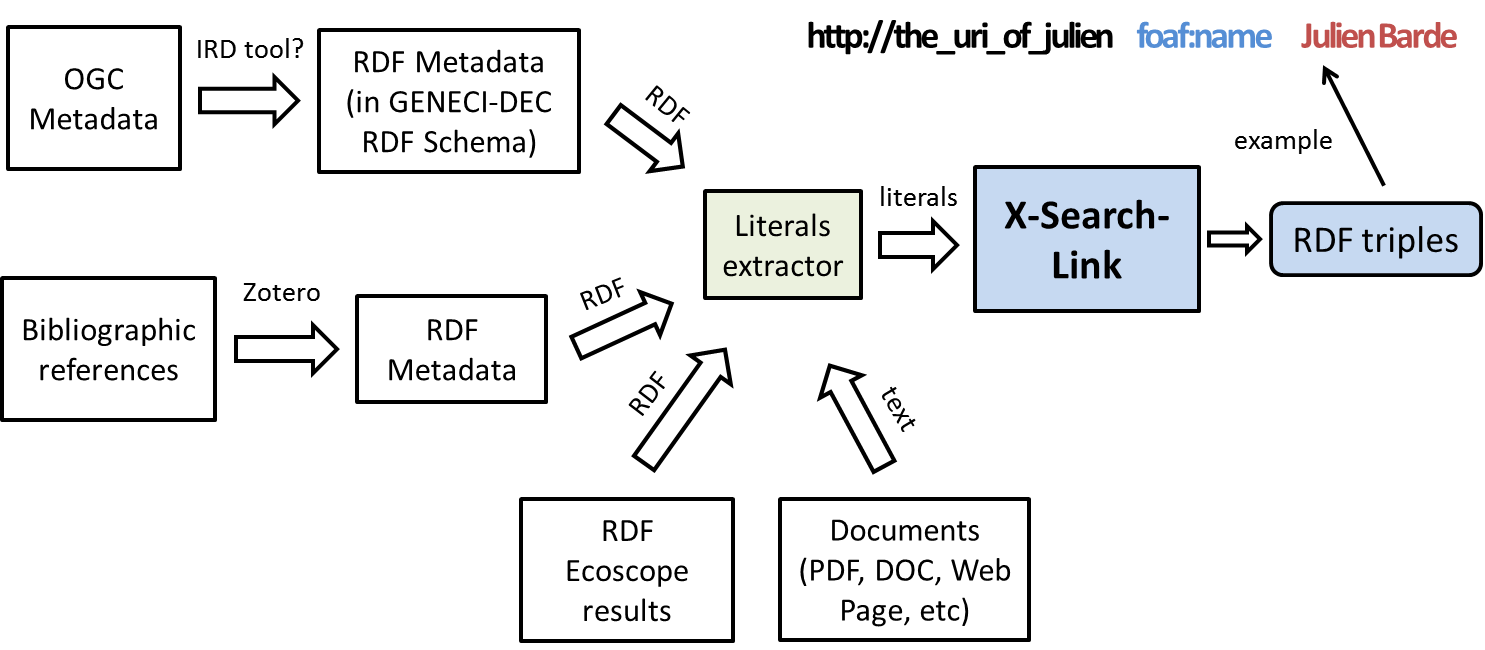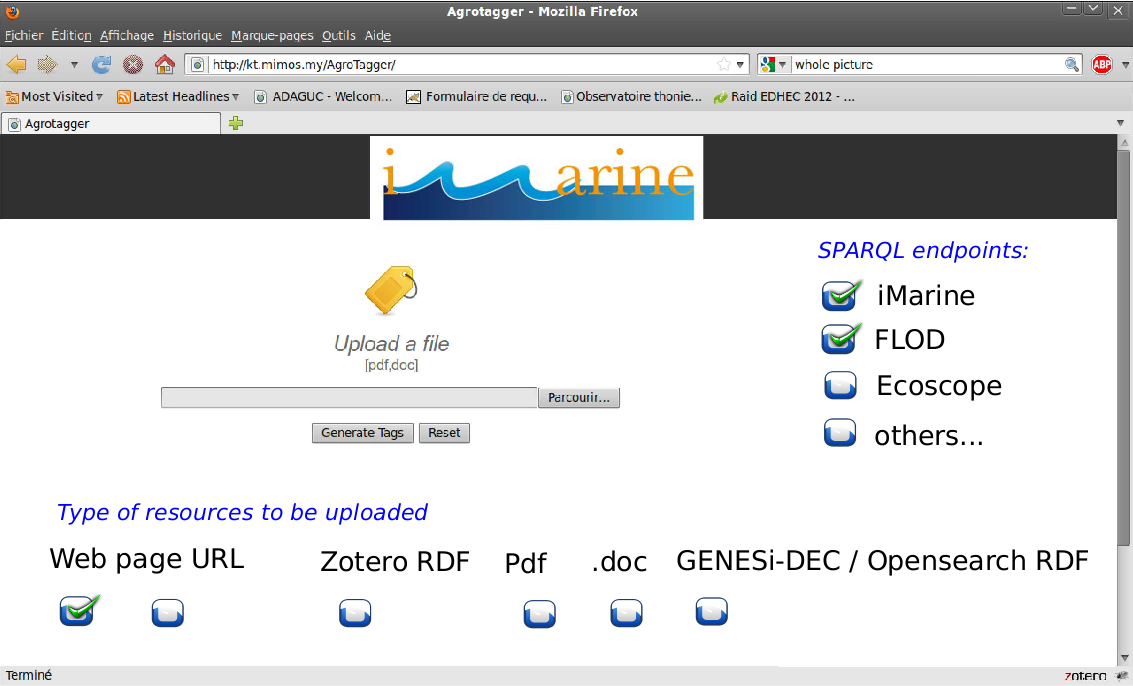X-Link
Contents
General Description
The requirements described in this page has led to the implementation of the X-Link system.
X-Link is a fully configurable (Linke Data-based) Named Entity Extraction (NEE) tool which allows the user/developer to easily define the categories of entities that are interesting for the application at hand by exploiting one or more (online) Semantic Knowledge Bases (Linked Data). The user is also able to update a category and specify how to semantically link and enrich the identified entities. This enhanced configurability allows X-Link to be lightly configured for different contexts, for building domain-specific applications (e.g. for identifying drugs in a medical search system, for annotating and exploring fish species in a marine-related web page, etc.).
A detailed description of X-Link (functionality, configurability, etc.) can be found at https://gcube.wiki.gcube-system.org/gcube/index.php/X-Link
Requirements
Persons responsible for editing/maintaining this page
- Pavlos Fafalios (fafalios@ics.forth.gr)
- Yannis Marketakis (marketak@ics.forth.gr)
- Julien Barde (julien.barde@ird.fr)
Description
The requirements concern the development of an application (library? RESTful service? ..?) that, based on a knowledge base, will be able to match named entities that lie in a file to URIs. The objective is to rely upon previous demonstrations of entity mining (highlighting terms in web pages) to fit some needs of the community of users that will create new linked open data available for different clients (e.g. search engines). Among data to be turn into linked data: bibliographic references, metadata (OGC from geospatial cluster, RDF results from opensearch complying with GENESI-DEC RDF schema), named entities in documents (Word, PDF files), etc.
In brief, the aforementioned application should:
a) read the content of a file (doc/pdf/XML/RDF) or web page as input,
b) discover named entities of interest (e.g. keywords, Species, Persons, Organizations, etc.) in that file,
c) match each discovered entity with one (ideally) or more entities from the underlying knowledge bases (i.e. URIs of TLO, FLOD, Ecoscope, etc)
The supposed process is sketched in the following figure:
Examples:
1) From following author description:
<foaf:Person>
<foaf:givenname>C.</foaf:givenname>
<foaf:surname>Mellon-Duval</foaf:surname>
</foaf:Person>
The tagger will find the triple of the related foaf:agent in Ecoscope SPARQL enpoint (or other endpoints):
http://www.ecoscope.org/ontologies/agents/capucineMellon foaf:name C.Mellon-Duval
2) From the following:
<dc:subject>
<z:AutomaticTag>
<rdf:value>Mediterranean</rdf:value>
</z:AutomaticTag>
</dc:subject>
The tagger will find the triple of the related ecosystem in Ecoscope SPARQL enpoint (or other endpoints):
http://www.ecoscope.org/ontologies/ecosystems/mediterranean_ecosystem rdfs:label Mediterranean
Difficulties/Challenges:
a) We must limit the probability of erroneous matchings “Entity-URI”. Possible Solution: a user will approve the matchings (however this may be laborious), or only URIs without ambiguity will be kept.
b) If for an entity we have matched more than one possible URIs, which one to select? Possible Solution: a user will select the right one (however this may be laborious).
Related iMarine WP/Tasks
It could be considered related to T10.4 - Semantic Data Analysis Facilities although it was not described in the corresponding milestone: Semantic_Data_Analysis
Related iMarine Deliverables
-
Related Milestones
-
Related Cluster
http://wiki.i-marine.eu/index.php/Semantic_cluster_achievements
Related Presentations/Tutorials
The system X-Link has been implemented.
Plans and Next Steps
A tentative plan is to:
a) understand the problem and define the requirements against the challenges (by end of Feb 2013),
b) decide what is required to be designed/implemented (by end of Apr 2013), and
c) plan and have a first implementation.
Demo Scenarios
(to describe one or more ideal scenarios)
The following figure (by Julien) depicts a possible application that exploits the functionality of X-Search-Link:
Design (tentative)
We propose to start from a software library (in future one could easily use it to provide a web service, or any other user interface, gcube-related or not gcube-related).
A rough description follows:
Setup
At setup time the user defines the desired categories and entity lists. To add a category (type) of entities user has to provide:
- a category name,
- a sparql endpoint,
- the URI of the resource class (type), e.g. http://www.ecoscope.org/ontologies/ecosystems_def#shark (or a SPARQL query that returns the desired lists of entities URIs).
When a new category of entities is added, X-Search-Link i) stores the sparql endpoint to use, ii) constructs a sparql template query which will be used for retrieving entities related to a string, and iii) stores a list of named entities belonging to the category (i.e. instances of the class) and for each entity one or more corresponding URI(s).
Input
To apply its functionality over a particular document the user has to specify:
- the document he wants to analyze (e.g. pdf, doc, rdf, xml, web page, etc)
- the categories of entities for which he wants to detect entities in the document (e.g. Countries, Species, Water Areas, etc, or all possible categories), subset of the categories defined at startup.
Output
The desired result is a list of entities, each described by a name and one or more URI(s).
A detailed possible specification (classes and method signatures), plus an example of how a client could use it, is given in the following page: XSearchLink Specification
We estimate that, a first implementation of the above specification, will require around 1.5PM.
Related Tickets
Requirements
Enriching RDF files with the URIs of Named Entities (#1187)
Implementation
X-Link: Enriching documents with the URIs of Named Entities (#1814)

